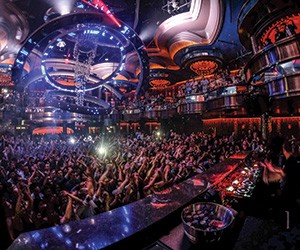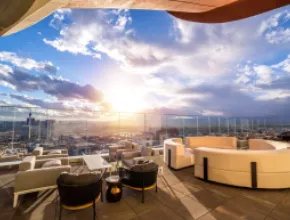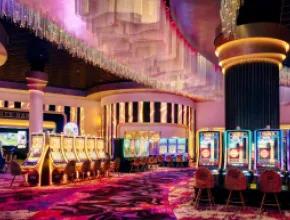Never have so many Eastern states been in play when it comes to casino gaming, their growth leaving new glitzy upscale options for meetings and conventions in their wake.
This year’s crop of major casino unveilings has included one—Ohio’s first—located in a former downtown department store; another at a Pennsylvania convention center; and still another at a Maryland mall.
State constitutions continue to be amended to allow or expand casino gaming, notably with the addition of such table games as poker, blackjack, roulette and craps. Pennsylvania and Delaware added table games in 2010.
On Nov. 6, Maryland voters will be asked if they want to have a sixth casino and add table games to existing casinos, and Rhode Islanders will vote on having table games at their two casinos. New York state could see such a table-game question confronting voters next year regarding its racetrack casinos.
Atlantic City
Atlantic City has moved on. It is no longer the city “Always Turned On,” a slogan that served it since 2003. In May it unveiled a rebranding campaign, “Do AC,” on which $30 million a year will be spent for five years, financed by casino revenues. Its television spots haven’t even mentioned gambling.
“Do AC” was prepared by the new Atlantic City Alliance, a public-private partnership initiated by the state to boost tourism. The city has lost more than one-third of its gaming revenues since they peaked in 2006, the year Pennsylvania opened its first casino.
“Everyone knows that Atlantic City is gaming. The focus of Do AC is on all the other things—the great entertainment, great restaurants, great beaches,” says Gary Musich, vice president, convention development at the Atlantic City CVA.
According to Musich, revenues at the Atlantic City Convention Center were up 15 percent last year and are expected to increase 10 percent this year. The average hotel occupancy for this year’s first half stood at 82.8 percent, up from 80.5 percent for last year’s period, excluding the new Revel, according to the CVA. Meetings and conventions delegates were up 9 percent. But gaming revenues dropped by a further 7 percent for the first 7 months, according to the NJ Division of Gaming Enforcement.
The city’s long-awaited 12th casino resort—the Revel—debuted in April. Overlooking the Boardwalk, the new $2.4 billion, 1,898-room property includes 14 restaurants, 10 pools, 160,000 square foot of indoor and 90,000-square-foot of outdoor event space, and a 130,000 square foot casino.
Others are being transformed.
Borgata Hotel Casino & Spa is completing a $50 million room design project. Tropicana Casino and Resort expects to complete by year’s end a $25 million renovation that includes 437 North Tower rooms.
And the former Atlantic City Hilton Casino Resort became the Atlantic Club Casino Hotel early this year.
The former 740-room Trump Marina was reflagged the Golden Nugget Atlantic City in April following a $150 million renovation by its new owners, Houston-based Landry’s. Also under new ownership is Resorts Casino Hotel, which will open a Margaritaville complex next May, and has contracted with a Mohegan Tribal Gaming Authority subsidiary to manage the property, subject to approvals.
In September, Hard Rock International scrapped plans for a casino hotel. It had been the only applicant to apply to build under 2011 legislation allowing for two smaller casino hotels. Previously, new casino hotels had to have a minimum of 500 rooms.
Atlantic City has seen a growing number of events and festivities. According to the Atlantic City CVA, in the last year more than 15 new restaurants have opened and there are 15 golf courses within a 30-mile radius.
In the area around the convention center, Tanger Outlets The Walk expanded early last year, adding a 20-store phase III. And serving the outlets and convention center, in March a new 1,182-space parking garage opened with 16,000 square feet of retail space.
Last year, consumers spent $3.32 billion on casino gaming in Atlantic City, a drop of 7 percent from 2010, according to the American Gaming Association (AGA)
Pennsylvania
A little more than $3 billion was spent in the Keystone State at its four-standalone casinos and six casinos at racetracks (racinos), a 21.3 percent increase over 2010. A boost came from table games installed in summer 2010 following enabling legislation.
The state had approved two smaller casinos at existing resorts (Category 3 casinos), but litigation from prospective competitors delayed plans. Now one has opened at Valley Forge and the other is preparing to begin construction.
The $150 million Valley Forge Casino Resort opened in March close to Valley Forge National Historical Park and King of Prussia Mall. It includes two existing hotels totaling 486 rooms that underwent renovations, and the Valley Forge Convention Center with more than 100,000 square feet of available space.
Its Casino Tower includes the former rebranded Valley Forge Scanticon Hotel & Conference Center along with a new 600-slot casino with 50 table games, seven new restaurants and a nightclub. The casino resort also includes Radisson Valley Forge Hotel.
The state Supreme Court in August upheld the April 2011 selection of the 318-room luxury Nemacolin Woodlands Resort in the Laurel Highlands for a Category 3 license. The resort is getting a $50 million Isle of Capri Casinos Lady Luck Casino with 600 slots, 28 table games and a restaurant and lounge.
“We anticipate beginning construction as soon as all of the approvals are in place and expect to open Lady Luck Nemacolin nine to 12 months after construction begins,” says Virginia McDowell, CEO of Isle of Capri Casinos.
The 3,000-slot Sands Casino Resort Bethlehem, which has 12,000 square feet of meeting space, opened its new 50,000-square-foot multipurpose event center in May. Last year it opened a 302-room hotel in June and an outlet shopping center in November.
The Keystone State’s first casino, Mohegan Sun at Pocono Downs in Wilkes-Barre, opened in November 2006 and held a July groundbreaking for a 238-room hotel with 20,000 square feet of meeting space. A late 2013 completion is expected.
“Since we first opened we knew that a hotel and convention center would greatly enhance our operation and make a more complete destination. The timing just had to be right,” says Bobby Soper, the property’s CEO.
In May, Harrah’s Chester, which has 14,000 square feet of meeting space, got a new name, Harrah’s Philadelphia Casino & Racetrack, along with three new dining outlets and 200 new slots.
The Poconos’ 188-room Mount Airy Casino Resort, which has 7,200 square feet of meeting space, in summer completed a new $1 million golf clubhouse and completed $2 million in gaming enhancements, launching five new table games and upgrading 200 of its 2,075 slots.
New York
The Empire State has a handful of tribal casinos and nine racinos. The five casinos with Class III tribal gaming boast both Las Vegas-style slots and table games.
The racinos—the first of which opened in 2004—only have electronic video lottery terminals (VLTs), which are connected to a network that controls payouts and play; they don’t have table games. Last year, consumers spent $1.26 billion at the racinos, 15.6 percent more than 2010.
In March, Gov. Andrew Cuomo approved a gaming bill that would amend the state constitution to allow table games. The legislature will take up the issue again next year for it to be placed on the November 2013 ballot. Opposition, however, can be expected from tribal operators.
Empire City Casino at Yonkers Raceway has said it is prepared to invest $310 million; including building a 400-room hotel and a 5,000 seat multiuse arena, if an amendment is approved.
One of the country’s largest racinos with 5,300-plus VLTs, Empire City has a $45 million expansion under way. It will open a 30,000-square-foot gaming addition this fall and two new restaurants by year’s end. Function facilities currently include a room holding up to 400.
The state’s ninth racino was unveiled in October 2011 at Aqueduct racetrack in Queens. Owned by Genting New York, a Genting Malaysia subsidiary, the Resorts World New York Casino includes around 5,000 VLTs and dining/entertainment venues.
Last January, Cuomo announced a deal with Genting for a 3.8 million-square-foot convention center and hotel complex. Then June 1 he announced on a radio show that the deal had fallen through.
The Seneca Nation operates three casinos.
Its Seneca Allegany Casino & Hotel in Salamanca, which has a 2,000-seat seat event center, will open a new $53 million hotel tower this fall, increasing its room count from 212 to 413. At the 457-slot Seneca Buffalo Creek in downtown Buffalo, work is under way on a new 800-slot casino expected to debut late next year.
It also has the 604-room Seneca Niagara Casino & Hotel in Niagara Falls, with 30,000 square feet of meeting space and a two-year-old Robert Trent Jones II -designed 18-hole golf course.
Across the falls in Canada, Niagara, Ontario has the 368-room Fallsview Casino Resort with 50,000 square feet of meeting space. Near Syracuse, the Oneida Nation operates the 700-room Turning Stone Resort & Casino with 100,000 square feet of meeting space and three golf courses.
Also, the St. Regis Mohawk Tribe operates the 1,600-slot Akwesasne Mohawk Casino in Hogansburg near the Canadian border, which completed a $55 million dining/casino expansion in 2010.
New England
Massachusetts legalized casino gaming last November. Gov. Deval Patrick signed a bill authorizing licenses for three full-resort casinos, one each in Greater Boston, the southeast and the west, plus one slots facility at a racetrack.
Formed in March, the Massachusetts Gaming Commission began taking preliminary applications in August.
In June, Suffolk Downs in East Boston and partner Caesars Entertainment Corp. unveiled plans for a $1 billion “world-class destination” with up to 5,000 slots, 200 tables and a hotel on the racetrack’s 160 acres. Caesars CEO Gary Loveman told those attending a televised press conference, “The most important thing to consider when you are building a facility like this is you want to make sure you are where you are wanted.”
Several cities have come out against gaming, including Foxborough, where Wynn Resorts dropped a proposed plan for a casino opposite Gillette Stadium, home of the NFL’s New England Patriots.
In late August, MGM Resorts unveiled plans for an $800 million entertainment district on 10 acres in downtown Springfield, an area heavily damaged by a June 2011 tornado. Components include a revived Main Street, a 250-room hotel and 89,000 square feet of gaming space.
Plainridge Racecourse, a harness track at Plainville southwest of Boston, has applied for a racetrack license and, like the Caesars and MGM projects, has paid the commission a $400,000 non-refundable application fee.
Rhode Island’s two casinos are Twin River in Lincoln, with over 4,700 slots and a 29,000-square-foot multipurpose event center, and the 1,000-slot Newport Grand Slots. Its gaming revenues increased 7.5 percent last year, according to AGA. Voters will have the chance— Question 1 in the Nov. 6 election—to approve table games for them.
In Maine, ribbon cutting occurred June 5 for the new Oxford Casino in Oxford, 45 minutes from Portland. It features 500-plus slots, a dozen table games and a bar and restaurant. Maine voters approved a casino in Oxford County in the November 2010 election.
Maine’s other casino, Penn National Gaming’s 151-room Hollywood Slots, Hotel & Raceway in Bangor, added table games early this year following approval by voters last November, when they also rejected a proposal for three more Maine casinos.
With just two Native American casinos, Connecticut provides the country’s fifth- largest casino market after Las Vegas, Atlantic City, Chicago and Detroit, dropping from fourth in 2010. State gaming revenues were down for the year ended June 30.
The 2,200-room Foxwoods and 1,000-room Mohegan Sun each has around 6,000 or more slots. Foxwoods Resort Casino and the MGM Grand at Foxwoods have a total of 160,000 square feet of meeting space and a 4,000-seat theater; Mohegan Sun has 100,000 square feet of meeting space.
Maryland and Delaware
Maryland now has three casinos and licenses have been awarded to build two others. In November 2008 voters approved a constitutional amendment allowing five casinos with a total of 15,000 VLTs. Stipulated locations are Baltimore, Anne Arundel, Cecil, Worcester and Allegany counties.
In August, Gov. Martin O’Malley signed a law that gives voters the chance to decide in the Nov. 6 election whether to allow table games and also to approve a sixth casino, which would be in Prince George’s County.
“By finally resolving this issue of gaming in Maryland, we have an opportunity to generate more than $100 million for our No. 1-ranked public schools, create 2,200 additional, permanent jobs and keep Maryland’s facilities competitive with surrounding states,” O’Malley stated in submitting the legislation.
The newest casino, the $500 million Maryland Live! Casino at Arundel Mills Mall in Anne Arundel County, opened June 6. Owned by The Cordish Companies, it had all components in place, including 4,750 slots and electronic table games, restaurants and a 500-seat performance venue, with a phase II opening in September.
The state’s first casino was the 1,500-slot Hollywood Casino Perryville, near Baltimore in Cecil County, in September 2010. Then, in January last year, the 700-slot Casino at Ocean Downs opened outside Ocean City in Worcester County.
In April, Evitts Resort, a Lakes Entertainment Inc. subsidiary, was selected. At its 215-room Rocky Gap Lodge & Golf Resort near Cumberland, it plans to convert 20,000 square feet of existing convention and meeting space into a gaming facility with a minimum of 500 VLTs, a bar and a food outlet. Work is slated to begin in November for an anticipated opening in the second quarter of 2013.
The last of the five casino licenses was awarded in late July to a joint venture of Caesars Entertainment and Midwest-based Rock Gaming LLC to operate a VLT facility in downtown Baltimore near M&T Bank Stadium. The $300 million Harrah’s Baltimore will include 3,750 VLTs. Construction is expected to begin in the second quarter of 2013 with a targeted opening in 2014’s second quarter.
Table games were installed at Delaware’s three racinos in early summer 2010. Delaware casino spending increased 1.3 percent in 2010, but dropped 3.3 percent last year, which is generally attributed to growing Maryland and Pennsylvania competition.
Casinos are at the 500-room Dover Downs Hotel & Casino, the state’s largest hotel, with 35,000 square feet of meeting space; Harrington Raceway & Casino, with group space for 400; and Wilmington’s Delaware Park, with an 18-hole golf course.
Ohio
Two of Ohio’s four proposed casinos opened in May: Horseshoe Casino Cleveland followed by Hollywood Toledo. Voters approved a constitutional amendment in November 2009 allowing one casino in each of its four largest cities, each with up to up to 5,000 slots and table games.
The $350 million Horseshoe Casino Cleveland is located in downtown Cleveland on four floors of the Higbee Building, a former department store. It includes 2,100 slot machines, 63 table games, a 30-table World Series of Poker room, a VIP players lounge and dining options that include a 400-seat buffet and a food court.
Its developer, Rock Ohio Caesars LLC, next spring also will open the $400 million Horseshoe Casino Cincinnati under construction in downtown Cincinnati. It will feature 2,000 slot machines, 85 table games and a lineup of restaurants that includes a Margaritaville. Rock Ohio Caesars is a joint venture of Rock Gaming and Caesars.
Penn National Gaming’s $320 million Hollywood Casino Toledo overlooks the Maumee River just west of I-75. It features about 2,000 slots, 60 table games and five dining choices.
The $400 million Hollywood Casino Columbus was set to open Columbus Day, Oct. 8. Located on the former General Motors/Delphi Automotive site on the city’s west side, it will include 3,000 slots, 70 table games and 30 poker tables, and more than 12,500 square feet of function space, including a main venue seating 650 for banquets.
Last summer lawmakers also passed a bill backed by Ohio Gov. John Kasich allowing racinos with VLTs at the state’s racetracks. Most of the state’s seven racetracks have applied and two have been approved.
The first opened in June with 2,125 VLTs at MTR Gaming Group’s Scioto Downs harness racetrack in Columbus. Also, with a proposed spring opening, Rock Ohio Caesars is building a racino with expanded F&B outlets and updated existing facilities at its Thistledown race track outside Cleveland.
Tony Bartlett has covered the hospitality and meetings industry for more than 20 years.






